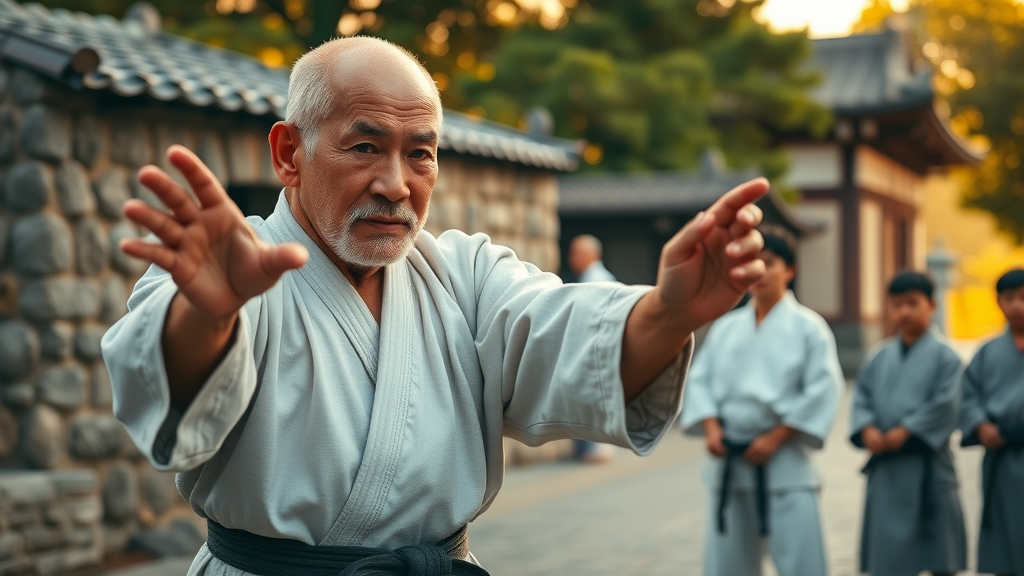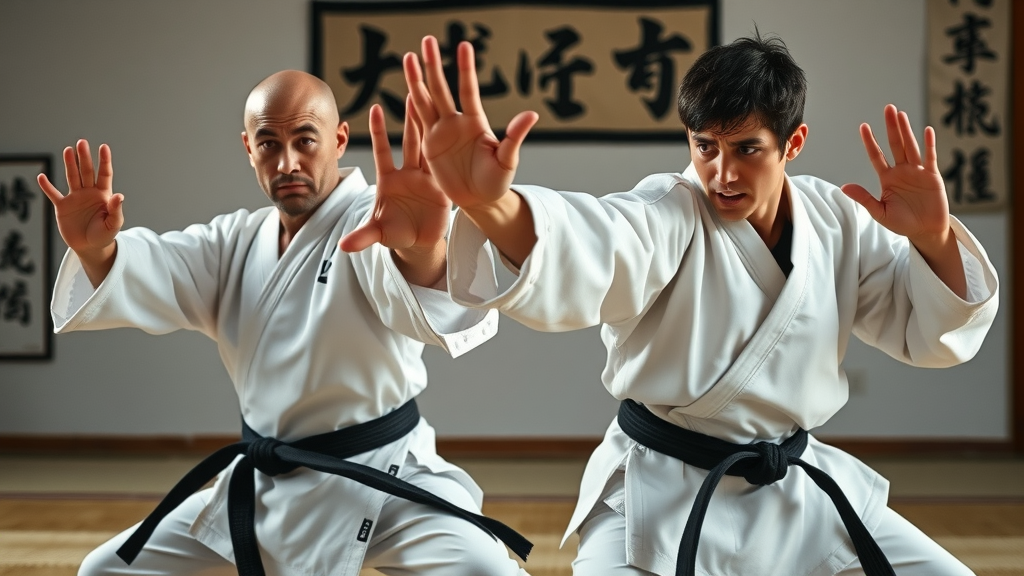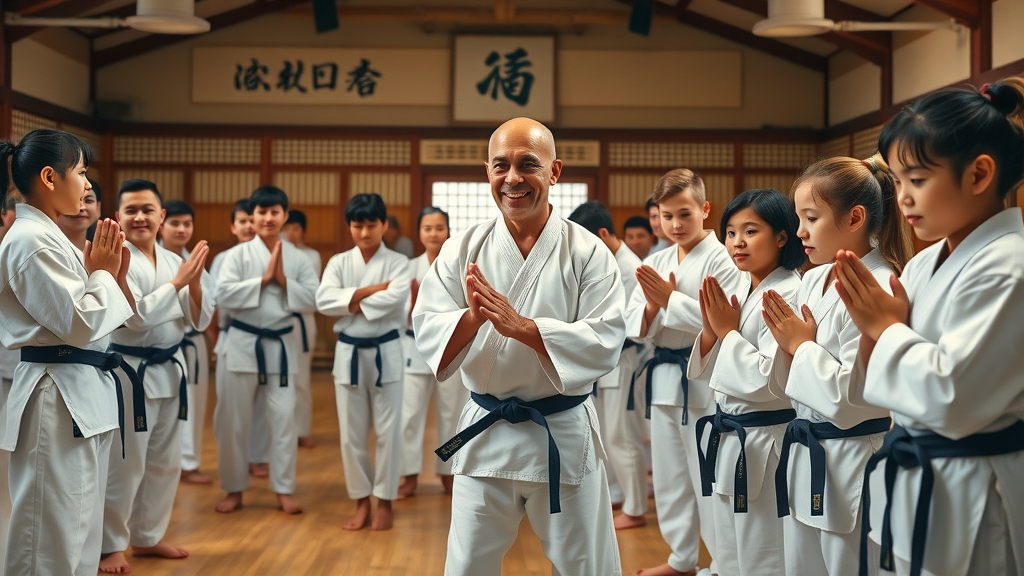- Did you know that nearly 80% of traditional karate schools around the globe trace their deep-rooted practices back to Okinawan martial arts training? Explore the unique legacy and modern benefits of this powerful discipline.

Okinawan Martial Arts Training: Cultivating Mind and Body Strength
- Understand how Okinawan martial arts training goes beyond physical skill to foster mental discipline, character, and a lifelong passion for self-improvement. See real-world transformations from global students and historical figures.
Okinawan martial arts training is celebrated not just for its combat effectiveness, but for the profound transformation it can bring, both inside and out. While many associate martial arts merely with punches and kicks, true Okinawan karate dives deeper, forming a bridge between rigorous physical conditioning and lifelong personal growth. Students across continents and ages, from bustling cities to quiet villages, report increased self-discipline, sharper focus, and newfound confidence after embracing training karate based on Okinawan roots.
This dedicated approach cultivates mental resilience and ethical character, drawing inspiration from centuries of tradition. Real-world examples highlight individuals—young teens combating anxiety, adults regaining lost vigor, and seniors enhancing mobility—who find renewed purpose and wellness through consistent practice. The legacy, shaped by renowned karate masters and preserved in dojos worldwide, continues to bridge old-world philosophy and contemporary lifestyles. Whether you dream of mastering kata or simply improving your well-being, Okinawan martial arts offers a holistic system for continuous self-improvement.
What You’ll Gain from Authentic Okinawan Martial Arts Training
- Comprehensive understanding of authentic Okinawan karate techniques
- Insight into centuries-old martial art philosophies
- Practical strategies for training karate at any age
- Access to essential resources for pursuing mastery
Enrolling in Okinawan martial arts training opens a gateway to skills that reach far beyond the dojo. You'll gain access to a comprehensive system where every karate technique serves a deeper purpose—enhancing balance, power, and adaptability. Programs focus on mastering fundamental movements, such as stances (kamae), blocks, strikes, and the art of kata. But the benefits extend further: you’ll absorb timeless philosophies rooted in discipline, respect, and perseverance, values esteemed by historic Okinawan karate masters and modern martial artists alike.
Authentic Okinawan karate encourages students of all backgrounds and ages. Whether you're navigating childhood challenges, seeking adult fitness, or looking for lifelong enrichment, the progressive structure ensures everyone advances at their pace. Beyond fighting skills, you’ll discover community, lasting mentorship, and practical life strategies. By tapping into essential resources—like well-curated curriculums, specialized karate camps, and guidance from experienced sensei—you truly set yourself on a path to mastery.
Exploring the Martial Art Origins: The Birthplace of Karate in Okinawa
Birthplace of Karate: Traditions and Historical Roots

- Okinawan martial arts training history
- Influence of Chinese martial arts
- Kanbun Uechi and key karate masters shaping Okinawan karate's evolution
The birthplace of karate lies on Okinawa Island, a crossroads where local defense techniques merged with ancient Chinese martial arts. This unique blend led to the creation of Okinawan karate , characterized by adaptive stances, practical movements, and a culture that celebrates respect and continuous improvement. Traditions developed during the Ryukyu Kingdom adapted to social changes during the World War II era, and Okinawa’s martial art forms have influenced karate schools worldwide.
Prominent figures such as Kanbun Uechi —the founder of Uechi-Ryu—played a pivotal role, having studied karate and other fighting styles in China before returning to Okinawa to develop and systematize his approach. The direct lineage of karate masters, from Chojun Miyagi (Goju-Ryu) to Gichin Funakoshi, illustrates a living history cherished through rituals, festivals (like Karate Day), and cultural heritage sites such as Okinawa Karate Kaikan. As one expert historian notes,
"Okinawa is revered as the birthplace of karate—a unique confluence of indigenous traditions and outside influence that created a globally respected martial art."
Today, the traditions of these martial artists inform the foundation of every training session held, honoring the discipline and philosophy passed down for generations.
Essential Okinawan Karate Techniques and Training Principles
Core Elements of Okinawan Martial Arts Training
- Stances (Kamae) and their functions
- Basic strikes and defensive maneuvers
- Kata: The structured forms at the core of Okinawan karate
- Conditional training and body hardening

Mastery in Okinawan martial arts training starts with a focus on core principles. Central to all practice are stances ( kamae ), meticulously taught to develop stability, power, and readiness. Each stance—like zenkutsu-dachi (front stance) or neko ashi-dachi (cat stance)—has specific applications for offense and defense. Beginners and advanced karateka alike devote many training sessions to refining these basics, as Okinawan karate emphasizes form and function working as one.
Beyond stances, students progress through a flowing system of blocks, punches, and kicks—each rooted in centuries of adaptation for real-world defense. Central to Okinawan karate is the kata : structured forms comprising a series of offensive and defensive movements. More than just choreography, kata are living archives encoding generations of techniques and tactics. Conditioning drills—including body toughening exercises—round out the regimen, ensuring that practitioners develop hardiness and mental discipline required both in the dojo and beyond.
Choosing an Okinawan Karate Camp: How to Train Like a Karate Master
Features of Okinawan Martial Arts Karate Camps
| Karate Camp Feature | Benefit | Example |
|---|---|---|
| Authentic Dojo Setting | Immersion in traditional training | Gruber's Karate, Gurnee |
| Instruction by Karate Masters | Direct lineage to old Okinawan styles | Sessions led by certified sensei |
| Varied Curriculum | Covers basics to advanced kata | All-level programs |
| Cultural Experiences | Insight into Okinawa’s heritage | Sato-style rituals |
Choosing the right karate camp is crucial for both new and experienced martial artists aiming for authentic growth in their Okinawan martial arts training. Premier camps, such as those at Gruber’s Karate in Gurnee, IL, offer full immersion —replicating the atmosphere of a traditional Okinawan dojo. Students are mentored by sensei who have direct ties to the core martial art lineages, ensuring a faithful transmission of knowledge and etiquette.
A modern karate camp experience goes beyond drills and kata. Participants benefit from a varied curriculum that adapts to all proficiency levels, introducing new techniques while reinforcing time-honored fundamentals. Cultural activities, including traditional Sato-ryu rituals or Okinawan history evenings, make these camps unique. By the end, students gain much more than improved fighting skills—they claim a deeper understanding of the philosophy and spirit that drive Okinawan karate traditions forward.
Famous Karate Masters and Their Influence on Okinawan Martial Arts Training
Karate Masters: Kanbun Uechi and Other Legends

- Kanbun Uechi’s legacy and the development of Uechi-Ryu
- Influence of other revered karate masters on Okinawan martial art forms
- Personal stories and teaching styles
Few figures have shaped the landscape of Okinawan martial arts training as profoundly as Kanbun Uechi . His journey from Okinawa Island to mainland China and back embodies the cross-pollination central to the martial art's ethos. After years of studying under Chinese masters, Uechi synthesized key elements to create Uechi-Ryu karate: a style noted for its powerful strikes, unique breathing techniques, and training karate practices that instill resilience and humility.
The influence of other legends, like Chojun Miyagi (founder of Goju-Ryu karate) and Gichin Funakoshi, echoes throughout dojos worldwide. They emphasized the role of character, etiquette, and relentless perseverance—qualities now synonymous with Okinawan karate. Modern karate masters share not only their skills, but also personal stories of growth, setbacks, and triumph. Their teaching styles celebrate adaptability, making sure each student finds their unique path within the broader tradition.
"True mastery lies not in physical prowess, but in the spirit of perseverance and respect nurtured through Okinawan martial arts training." — Karate Master
Today, these teachings resonate strongly with karate practitioners everywhere, serving as inspiration for anyone beginning their own martial journey. Their legacies live on through the values, techniques, and mentorship that form the bedrock of every training session.
Karate Master Tips: How to Begin Your Own Okinawan Martial Arts Training Journey
- Find a reputable dojo with an authentic lineage (like Gruber's Karate in Gurnee, IL)
- Start with foundational karate drills and kata
- Commit to regular practice and cross-training
- Embrace the philosophy and etiquette of Okinawan martial arts
- Engage with a mentor or karate master for advanced guidance
Starting your own Okinawan martial arts training journey is more straightforward than you might imagine. The first step is identifying a trusted dojo with a proven connection to traditional Okinawan lineages, ensuring you benefit from authentic methods and philosophies. Once enrolled, begin each training session focusing on the basics—stances, drills, and fundamental kata—building your foundation layer by layer.
Commitment is key: regular practice, even if brief, leads to steady progress and deeper understanding. Many students complement dojo lessons with cross-training activities like stretching or strength work at home. As you advance, embracing the full culture—rituals, etiquette, and philosophy—offers a richer experience. Finally, never underestimate the power of mentorship. An experienced karate master or senior student can provide personalized insights, guiding you past challenges and inspiring lasting motivation.
What makes Okinawan karate different?
- Okinawan karate distinguishes itself with its focus on close-quarters defense, natural movements, and a holistic approach emphasizing character development as much as physical technique. Kata forms are unique, and conditioning practices prepare students for real-world encounters.

Okinawan karate stands apart from other martial arts traditions—especially modern Japanese karate—through its distinctive self-defense focus and whole-person approach. Techniques prioritize close-quarters efficiency, utilizing natural body mechanics and swift, practical responses. Unlike other systems which sometimes emphasize point scoring or sport applications, the heart of Okinawan martial arts is real-world readiness and self-mastery.
Unique kata sequences, innovative conditioning drills, and persistent character training help practitioners develop resilience, adaptability, and profound inner strength. The emphasis on mental discipline is just as strong as the focus on physical skill, making Okinawan karate a lifelong discipline rather than just a form of exercise or competition. This makes it accessible and beneficial to people from all backgrounds and ages.
What is the fighting style in Okinawa?
- Okinawa’s fighting style traditionally blends indigenous self-defense methods (te) with influences from Chinese martial arts. It is characterized by strong stances, rapid blocking, striking, and practical self-defense tactics tailored for the realities of Okinawan life.
The fighting style in Okinawa traces its lineage back to techniques developed on Okinawa Island known as "te," meaning "hand." Over centuries, these methods absorbed elements from southeast China and, later, from encounters with practitioners arriving on the island. As a result, Okinawan karate evolved to focus on real, practical self-defense for ordinary people rather than elaborate sport or military combat.
Strong stances provide balance and rootedness, while fast, direct blocks and strikes allow for decisive action even in tight spaces. Traditional training karate in Okinawa also includes joint locks, grappling, and conditioning routines (such as makiwara striking), ensuring readiness for the unpredictable realities of daily life. This holistic approach is why so many martial artists worldwide, from World War II veterans to modern competitors, value Okinawan styles for their blend of tradition and adaptability.
Can you train karate in Okinawa?
- Absolutely. Okinawa welcomes global students to train in local dojos, participate in karate camps, and immerse themselves in the authentic rituals and methods passed down by karate masters. Many international programs connect students with historic schools and sensei.

If you dream of experiencing karate training at its source, Okinawa is open and welcoming to global students. Numerous dojos, famous for their history and connection to legendary masters, offer programs ranging from short-term intensives to immersive long-term martial arts study. Events like Karate Day and world karate championships bring together martial artists from across continents, creating a vibrant, supportive community.
Many programs are designed for international visitors—with English-language instruction, cultural orientation, and guidance through important Okinawan etiquette and history. Some camps, including those run in partnership with the renowned Okinawa Karate Kaikan , offer a window into exclusive rituals and mentorship opportunities unavailable anywhere else. Whether you’re a complete beginner or a seasoned martial artist, you’ll find your place in Okinawa’s living karate tradition.
What is the best Okinawan karate style?
- Uechi-Ryu, Goju-Ryu, and Shorin-Ryu are among the most respected Okinawan karate styles. The 'best' style often depends on personal goals—each has its own unique philosophy, kata, and training methods for students to explore.
The question of the best Okinawan karate style invites lively discussion among practitioners. Three primary schools— Uechi-Ryu, Goju-Ryu, and Shorin-Ryu —stand out for their history, breadth, and distinctives. Uechi-Ryu is renowned for tough conditioning and focused, circular movements, a legacy of Kanbun Uechi's studies in China. Goju-Ryu, created by Chojun Miyagi, blends hard and soft techniques, emphasizing deep breathing, tension-releasing motions, and smooth transitions from defense to offense.
Shorin-Ryu, tracing roots to both Okinawan and Chinese traditions, is known for light footwork and swift, linear strikes. Each style offers unique kata and philosophies, so the "best" choice depends on your personal goals: whether you seek rigorous physical conditioning, fluid adaptable movements, or a strong foundation in traditional forms. Most dojos—especially those connected to Okinawan lineages—encourage students to explore and adapt techniques that suit their bodies and aspirations.
Essential FAQs: Okinawan Martial Arts Training
- How quickly can you progress in Okinawan martial arts training?
- Are there opportunities for competition?
- What equipment is needed to start training karate?
- Who can benefit from practicing Okinawan karate?
- How does Okinawan karate differ from Japanese karate disciplines?
Q: How quickly can you progress in Okinawan martial arts training? A: Progress varies based on dedication, consistency, and natural aptitude. Beginners often see improvements in balance, focus, and confidence within a few months. Advancing through belt ranks in traditional Okinawan karate may take several years, as emphasis is placed on mastery over speed.
Q: Are there opportunities for competition? A: Yes—while Okinawan karate values self-development over rivalry, many dojos participate in tournaments and kata competitions. Events range from local club sparring to major international meets, encouraging friendly challenge and skill display.
Q: What equipment is needed to start training karate? A: Beginners need minimal gear: a traditional karate gi (uniform), a belt signifying their rank, and an open mindset. As you progress, you might use protective pads, striking targets, or specialized apparatus based on your dojo’s curriculum.
Q: Who can benefit from practicing Okinawan karate? A: Almost everyone! Children, teens, adults, and seniors all find value—whether in fitness, discipline, self-defense, or community. Okinawan martial arts training adapts to individual abilities and goals.
Q: How does Okinawan karate differ from Japanese karate disciplines? A: While related, Okinawan styles often maintain closer ties to original self-defense roots, using more natural movements and emphasizing whole-person growth. Japanese karate (refined after World War II) may stress sport competition or formalized techniques more rigidly.
Key Insights from Okinawan Martial Arts Training
- Consistency and patience are vital to mastery
- Character development is as essential as technique
- Finding the right dojo and mentor sets the foundation for success
As you embark on your Okinawan martial arts training journey, remember that the most significant advances come from steady, patient practice. The art is as much about building character as it is about learning effective self-defense. Seek a dojo whose lineage and community feeling resonate with you, and pursue guidance from experienced sensei to ensure lasting growth.
Ready to Experience Okinawan Martial Arts Training?
- Build confidence, discipline, and strength. Enroll NOW at Gruber’s Karate , Gurnee’s 5 Star Rated Trusted Martial Arts Center! Sensei@gruberskarate.com Gruber's Karate, 5725 Stearns School Rd, Gurnee, IL 60031 Call : (224) 347-6655 GrubersKarate.com
Exploring the rich heritage of Okinawan martial arts training can be further enhanced by delving into the unique characteristics of its various styles. For instance, Gōjū-ryū is renowned for its blend of hard and soft techniques, emphasizing both linear attacks and circular movements, along with a strong focus on correct breathing and body conditioning. ( en.wikipedia.org ) Similarly, Shōrin-ryū combines elements of traditional Okinawan fighting styles, characterized by natural stances and fluid movements, promoting agility and flexibility. ( en.wikipedia.org ) Understanding these styles provides deeper insight into the diverse approaches within Okinawan karate, enriching your training experience.
 Add Row
Add Row  Add
Add 




Write A Comment